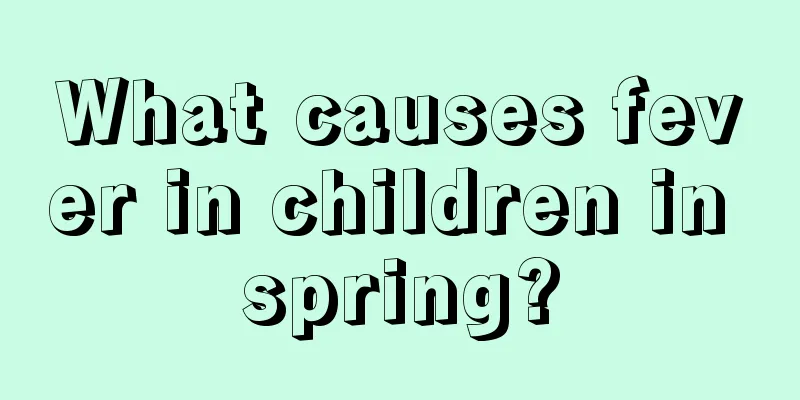What causes fever in children in spring?

|
The temperature in spring is unstable, with changes from hot to cold. The climate is also relatively dry, making it a season when diseases are more prevalent. Children, in particular, have weaker resistance and spend a long time in crowded public places such as schools. They are particularly susceptible to infectious diseases, which can cause fever and the like. Some parents will treat their children as if they have a cold or fever, which can easily delay the child's illness. Kindergartens are places where children gather, and awareness of identifying and preventing diseases, especially infectious diseases, must be improved. A kindergarten teacher said that a few days ago, a child in the class had a fever and small blisters appeared in his mouth. Everyone thought it was a common "cold and fever" and didn't take it seriously. A few days later, more than 10 children in the class developed the same symptoms, and the substitute teacher was unfortunately also infected, so they had to go home to rest and receive treatment. Parents should also have a basic understanding of infectious diseases that are prone to occur in spring and remain vigilant. A mother said that her son suddenly caught a cold and had a fever, and she thought it was just a common cold, so she took cold medicine on her own. Unexpectedly, not only did his son's condition not improve, but he also developed a rash on his body. Helplessly, the mother took her son to the hospital for examination, and the result was contagious chickenpox. Fever is only the initial symptom of chickenpox. Fever symptoms in children in spring may be caused by diseases such as chickenpox, pharyngocjunctival fever, and herpetic pharyngitis. Since the initial symptoms of these diseases are fever, and parents lack relevant knowledge, they can easily mistake them for colds, leading to delayed treatment. Pharyngocanthal fever: red eyes and loss of appetite Pharyngoconjunctival fever is an upper respiratory tract infection caused by a specific adenovirus. This disease often occurs in spring and summer, is transmitted through the air, and causes cross infection among young children. The early symptoms of pharyngocanthal fever include fever, sore throat, red eyes, and anorexia. During the examination, some lumpy secretions can be seen in the child's pharynx. The course of this disease is 1 to 2 weeks. Parents should seek medical attention promptly and not blindly use antibiotics on their children. In addition, supplementing with multiple vitamins and trace element zinc can also help recovery from the disease. Herpetic pharyngitis: high fever and sore mouth As the temperature rises in spring, it is easy to cause upper respiratory tract infection such as herpetic pharyngitis. Herpetic pharyngitis is mainly caused by viruses and often occurs in spring and summer. Recently, the hospital has seen more children of this type. Since it is transmitted through the air and causes cross infection, small-scale epidemics may occur. The disease mostly occurs in children aged 1 to 3 years old. The early symptoms of herpetic pharyngitis are very similar to those of a cold, manifested as sudden high fever, and children will have symptoms such as sore throat, drooling, and anorexia. During the examination, it can be seen that the child's pharynx is congested, and there are varying amounts of gray-white blisters in the pharyngeal palatine arch and other places. After a few days, the herpes expands and ulcers form. Severely affected children may also develop ulcers on other parts of the mouth, such as the gums and tongue. The course of herpetic pharyngitis is about one week. During the illness, if the child has persistent high fever, oral ulcers, etc., parents should take the child to the hospital for examination as soon as possible. Chickenpox: painful rash on body Varicella is an infectious disease with an acute onset and high contagiousness. Children are particularly susceptible to it in the spring. Chickenpox is an infection caused by the varicella virus. It has an acute onset and children will experience fever, body aches, etc. Rashes started to appear on the body. In the early stages, they were small red papules, which soon turned into blisters with serous substance in the blisters. After a few days, the blisters broke and scabs formed. At the same time, the patient's body itching is particularly obvious. Chickenpox is mainly transmitted through the respiratory tract via droplets, and can also be transmitted through contact with dust, clothes, utensils, etc. contaminated with the virus. Once you have chickenpox, you should be isolated and it is best not for the child to go to kindergarten until he or she recovers. Children should be especially careful not to scratch the blisters when their skin is itchy to avoid infection. Parents must pay attention to adding clothes for children in changeable weather, and often take their children to participate in sports and exercise that are suitable for them. This can help children improve their resistance and immunity, so that they will not get sick or have a fever easily. Every child is our angel, so we will be happy only when the angel is healthy. Parents must take good care of their children. |
<<: What is the standard weight for newborns?
>>: Case presentation of renal cyst in children
Recommend
Can children soak their feet when they have a fever?
It is normal for children to have poor body resis...
What is the best age to learn Taekwondo?
Nowadays, Taekwondo is not a skill that only boys...
Can a 10-month-old baby drink soy milk?
Soy milk is a very nutritious drink. Drinking soy...
How to treat cerebral palsy in children?
Some children suffer from cerebral palsy, which s...
What should I do if my baby cries after pooping?
Babies have to metabolize every day, which is a m...
Where should I scrape the child when he has a fever?
Children’s health is an important topic that ever...
What happens if my child has white spots on his body?
If a child has white spots on his body, it is ver...
Normal neonatal breathing and consequences
With the development of the times and the impleme...
Girls' hair style is simple and beautiful
People say that girls are their father’s lovers i...
The child has a fever and has yellow eye mucus
It is a very common symptom in daily life for chi...
Will babies kick their legs when they have flatulence?
Babies are relatively young and their stomachs ar...
Do three-year-old babies need to be dewormed?
When children are growing up, parents need to be ...
Why do children reach the age of tooth replacement but have not yet changed their teeth?
When children reach a certain age, they will star...
Eat these foods regularly and your child will never become nearsighted
Children are a high-risk group for myopia, which ...
What are some ways to cultivate children's sense of security?
Not all children are born as good as we imagine, ...









